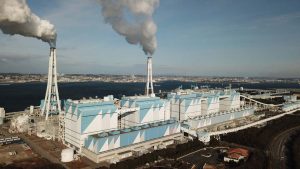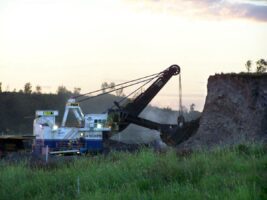The climate system will heat well past 1.5 degrees Celsius (°C) and perhaps up to 2°C without any further fossil fuel emissions. That’s the conclusion to be drawn from new research which should also help demystify the rhetoric from the 2015 Paris climate talks of keeping warming to below 1.5°C .

It’s not that 1.5°C isn’t dangerous: in fact, at just 1–1.1°C of warming to date, climate change is already dangerous.
A safe climate would be well below the present level of warming, unless you think it is OK to destroy the Arctic ecosystem, tip West West Antarctic glaciers into a self-accelerating melt, and lose the world’s coral reefs, just for starters.
The new research quantifies the effect of losing the very temporary planetary cooling provided by atmospheric aerosols.
Aerosols (including black-carbon soot, organic carbon, sulphates and nitrates and dust) are very short-lived particles in the atmosphere that have a cooling impact that lasts around a week.
Most of these aerosols are anthropogenic, that is produced by human activity, and most of the anthropogenic aerosols are a byproduct of the extraction and burning of fossil fuels.
Perhaps best known are the polluting sulphates and nitrates from coal-fired power stations, that combine with water molecules in the atmosphere to produce what is popularly known as “acid rain”.
The problem is our “Faustian bargain”: these aerosols are keeping the planet cooler than it would otherwise be, but are coming from burning fossil fuels that pour carbon dioxide (CO2) into the atmosphere, heating the planet for centuries to come.
The absolutely essential moves to eliminate fossil fuel emissions will also cut the cooling aerosol impact; the net effect will push the planet towards very dangerous warming conditions.
The big question is how much would that warming be?
A number of scientists have estimated the figure at around 0.5°C. Writing in the Huffington Post in late 2015, Prof. Michael E Mann noted:
While greenhouse warming would abate, the cessation of coal burning… would mean a disappearance of the reflective sulphate pollutants (aerosols) produced from the dirty burning of coal.
These pollutants have a regional cooling effect that has offset a substantial fraction of greenhouse warming, particularly in the Northern Hemisphere.
That cooling would soon disappear, adding about 0.5°C to the net warming…
So evidently, we don’t have one-third of our total carbon budget left to expend, as implied by the IPCC analysis. We’ve already expended the vast majority of the budget for remaining under 2°C. And what about 1.5°C stabilization? We’re already overdrawn.
Now, new research published last week, “Climate Impacts From a Removal of Anthropogenic Aerosol Emissions”, has looked at the aerosols issue in more detail in.
The work uses the latest generation of climate models, in which the aerosol-cloud interaction is more sophisticated, and also examines each aerosol component discreetly, rather than lumping them together as some simpler climate models do.
One limitation is that this research utilises four climate models, whereas big inter-comparison projects are based on around 30, so more work needs to be done on these results.
Bjørn Samset of the University of Oslo and his colleagues used four climate models, which cover a range of climate sensitivities, to see what would happen to the global average temperature if the short-lived greenhouse gases (methane, nitrous oxide etc) were kept at their current level, but CO2 emissions ceased once they have reached a level of 420 parts per million (ppm). (This is 15 ppm above the current level of 405 ppm, or just another five years of emissions at the current rate.)
The result was average warming of 1.35°C over the four models, above a late 19th century baseline. (It has been demonstrated that global average temperatures increase while CO2 is increasing, and then remain approximately constant until the end of the millennium despite zero further emissions.)
They then asked what would happen if all anthropogenic aerosols emissions were to cease.
The answer was that “removing aerosols induces a global mean surface heating of 0.5–1.1°C”, with a multi-model mean of 0.7°C. Samset says the vast majority of this net temperature change would be due to sulphate emissions from fossil fuel sources.
This is because, in general terms, the other two forms of anthropogenic aerosols — black carbon and organic carbon, which have major contributions from biofuel and other biomass burning — cancel each other out, at roughly 0.1°C each, one cooling and one warming.
In other words, going to zero emissions with CO2 at ~420ppm would result in a warming of around 2°C at equilibrium, if the level of short-lived gases was constant.
Not going to zero emissions would be worse in the short term: other recent work shows warming would be 2.2-2.4°C by 2050 if we continue on the current high-emissions path.
And it would be disastrously worse not to go to zero emission very fast, due to the longer-term impacts: continuing on the current high-emissions trajectory would bring warming of 4.1–5°C by 2100.
A new UK Met Office forecast released yesterday on climate conditions for 2018-2022 say that “over the whole five-year period… global average temperature is expected to be between 1.10°C and 1.40°C relative to pre-industrial conditions”, which would likely be warmer than the record-breaking El Nino year in 2016 of 1.14°C. And the Met says there is a 10% chance one of those years will bust through 1.5°C.
So whereas the Paris agreement delays strong action for decades, and serious carbon drawdown till the second half of this century, the brutal fact is that present greenhouse gas levels are such that we will steam past 1.5°C, and are heading to 2°C as a result of what we have already done.
And that is why all “1.5°C scenarios” actually “overshoot” to around 2°C before cooling the system by a theoretical, massive-scale carbon drawdown.
It is possible and necessary to reduce the warming impacts of the short-lived gases impacts, which is calculated to be around 0.9°C, of which methane is the largest component.
Half the methane emissions are natural, primarily from wetlands. And half are from human activities, the most important sources being extracting and processing fossil fuels (26-32%), livestock (26-28%), and landfills/waste (20-27%). Stopping the use of fossil fuels would reduce total methane emissions by 15%.
Eliminating methane from animal husbandry and rice production would cut methane emissions by 20%. Together this impact would be around 0.3-4°C.
On the other hand, it is expected non-anthropogenic methane emissions from wetlands and the Arctic will increase.
If the planet warms enough, large polar permafrost and/or methane clathrate carbon stores will be mobilised, releasing large amounts of both methane and CO2, and introducing large positive feedbacks to long-term climate change.
In February 2013, scientists using radiometric dating techniques on Russian cave formations to measure melting rates warned that a 1.5ºC global rise in temperature was enough to start a general permafrost melt.
The resilience of natural carbon sinks is deteriorating, and there is also evidencethat carbon stores in tropical rainforests are now flipping to become sources of carbon, both CO2 and methane.
So the work by Samset and his colleagues has added new understanding as to where the climate system is heading, even as we reduce fossil fuel use.
If large-scale methane emissions reduction are difficult due to human system inertia and/or non-anthropogenic increases, or if carbon cycle feedbacks kick in as they now appear to be starting to do in both in the tropics and at the poles, then we are heading past 2°C by mid-century, regardless of whether we continue on a high-emissions path, or on a zero-emissions path that also unravels the aerosol cooling.
It is also possible to deploy carbon drawdown, but this is not yet available at sufficient scale to meet the Paris schema, and research funding has so far been grossly inadequate.
(Removing around 150 billion tonnes of CO2 from the atmosphere would reduce warming by ~0.1°C.)
The storage of atmospheric carbon envisaged in the Paris agreement –– which delays emissions reductions now in favour of high levels of carbon drawdown much later in the century –– is enormous. Some of the world’s leading scientists recently noted that:
The scale of the decarbonisation challenge to meet the Paris Agreement is underplayed in the public arena. It will require precipitous emissions reductions within 40 years and a new carbon sink on the scale of the ocean sink. Even then, the world is extremely likely to overshoot.
A catastrophic failure of policy, for example, waiting another decade for transformative policy and full commitments to fossil-free economies, will have irreversible and deleterious repercussions for humanity’s remaining time on Earth.
Thus, without solar radiation management (replacing anthropogenic aerosols from fossil fuel use with anthropogenic aerosols spread from planes or fired into the atmosphere) it will be difficult to avoid 2°C no matter what CO2 emissions path we take, and all but impossible not to overshoot 1.5°C by at least a third.
It is not yet clear that there is demonstrable clear net environmental benefit from solar radiation management, and we should only do it if that is the case.
But in not doing it, we need to be honest about what will be lost and what further tipping points may be crossed.
And all the above figures are based on a late-19th-century baseline, not true pre-industrial which could add ~0.2°C to the figures.
The numbers from Samset et al. are close to those of Xu and Ramanathan, who found that by 2015, the combined effect of CO2 and short-lived climate pollutants impact was 1.9°C, less total aerosol forcing of 0.9°C, resulting in the observed warming of 1°C.
It is also close to Baker, Collins et al, who found elimination of aerosols would result in warming of 0.82°C (average across 3 models). And it accords with work published in 2013 by Hansen and others which found that aerosol cooling probably reduced global warming “by about half over the past century”.
The work by Samset et al. also looks at the impact of aerosol removal on rainfall and extreme weather. It finds that precipitation increases 2–4.6%, and extreme weather indices also increase.
There is a higher sensitivity of extreme events to aerosol reductions, per degree of surface warming, in particular over the major aerosol emission regions such as China and India.
The problems posed are wickedly exquisite. The former NASA climate science chief James Hansen has long warned that 2°C is a “recipe for disaster”.
It is clear that we now face an existential threat to human civilisation as the climate teeters on the edge of passing further system tipping points that would make the task of avoiding that threat tremendously difficult.
This requires an emergency response, where we as a society are actually prepared to say openly and often that the scenarios outlined above are real and alarming, and take action accordingly.
In Ireland, a Climate Emergency Measures Bill to be debated this month seeks to ban any new explorations for oil, coal, and gas on Irish territory.
The bill was introduced by People before Profit (PBP) Deputy Brid Smith last November, where it successfully passed the first stage. That would be one early step in an emergency approach.
Source: Climate Code Red. Reproduced with permission.










